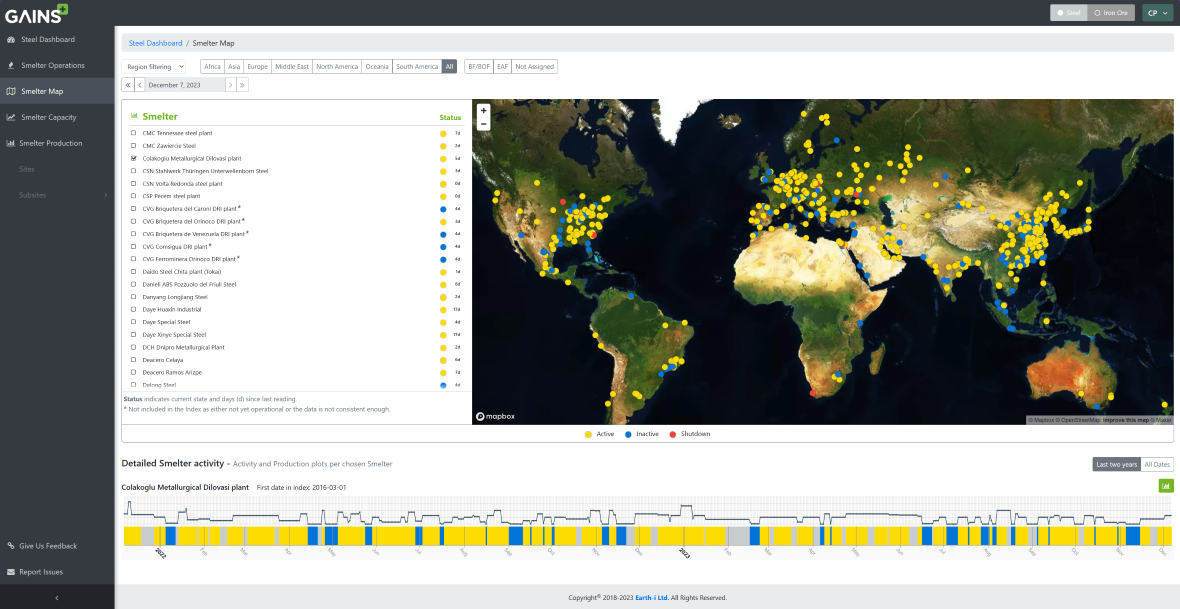
UK satellite and Earth observation specialist Earth-i has successfully delivered an operational system which provides up-to-date information on global supply chains for metals and minerals. The Global Activity Indices from Space (GAINS) project, developed under ESA’s Business Applications and Space Solutions (BASS) programme, focuses on two key areas - global steel smelting operations and movements of iron ore for steel production - and has already gained its first customers, underscoring the sector’s appetite for such a system.
Earth-i’s GAINS service monitors and tracks activity at numerous globally distributed industrial sites to provide high-frequency indicators of activity in complex supply chains, with a focus on sites producing tradeable goods and high-value commodities. Two products were developed as part of the project: a steel smelter activity monitoring service that covers over 95% of known global steel production, and an iron ore stockpiles product focusing on Chinese ports.
Recognising that ground sources can be unreliable and patchy, GAINS uses a mix of very-high, high, medium and low resolution Earth observation data to deliver data-agnostic geospatial insights in a format that is easy for non-technologists to understand and use. The two initial products use different automated methods to process the data, including artificial intelligence, machine learning, spectroscopic analysis and volumetric calculations.
The steel smelter product offers daily monitoring and a continuous dataset dating back to 2016, enabling users to aggregate data by company, country or region, or have custom filters, with options to compare production between different countries or regions. Globally, there are over 1200 sites related to steel production, of which around 800 are operational.
Francesco Feliciani, Head of the Company Led Projects Division at ESA, said “We are pleased to have supported Earth-i in the development of this service which has been well-received by industry, having already been adopted by targeted customers.”
Target markets for GAINS include traders, asset owners, market research companies and regulators. GAINS can provide data down to individual asset performance level or aggregated up to a macro-economic level, depending on the requirements of each trader. Meanwhile, market regulators can use the data to better understand market movements and validate information being reported by industrial operators.
Earth-i launched the live operational GAINS service in May 2023 on a subscription basis. It currently uses optical satellite data of different resolutions from multiple operators, but will later expand to include radar and thermal imaging data, with the programme designed to accommodate other satellite and remote-sensing sources as well as new open source datasets.
Charles Davis, CEO at Earth-i commented “The GAINS service demonstrates the power and scalability of fusing Earth Observation (EO) data and AI to be able to monitor, process and analyse over 1,000 sites dispersed around the globe on a daily basis to a high level of accuracy, and at a low cost. At a time that supply chains are becoming more opaque and more complex, GAINS provides the near-real time transparency our customers require to gain a competitive advantage by being able to validate data 30-90 days ahead of their competition. Earth-i is grateful to ESA and the UK Space Agency for their support to the GAINS project.”
The scalable architecture developed and demonstrated under the BASS project will enable Earth-i to add more product lines in future, such as lead, zinc and other commodities, and extend coverage along entire production chains in specific industries. With scrap steel smelting set to become a major focus in the steel industry, the company is also looking at a scrap steel stockpile monitoring product; the European Union has set a target of 40% of capacity to adopt this approach by 2032. With a transition to electric smelters predicted to result in 80-95% reduction in emissions, Earth-i also has plans to monitor and forecast the pollution caused by steel smelting, to support regulators and authorities to improve the environmental impact of the industry.


